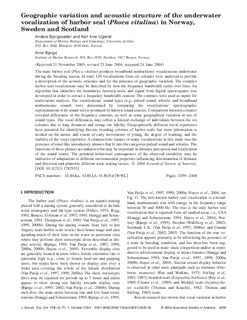| dc.contributor.author | Bjørgesæter, Anders | |
| dc.contributor.author | Ugland, Karl Inne | |
| dc.contributor.author | Bjørge, Arne | |
| dc.date.accessioned | 2007-07-06T06:41:09Z | |
| dc.date.issued | 2004 | |
| dc.identifier.uri | http://hdl.handle.net/11250/108254 | |
| dc.description | Journal home page: http://scitation.aip.org/jasa/ | |
| dc.description.abstract | The male harbor seal (Phoca vitulina) produces broadband nonharmonic vocalizations underwater during the breeding season. In total, 120 vocalizations from six colonies were analyzed to provide a description of the acoustic structure and for the presence of geographic variation. The complex harbor seal vocalizations may be described by how the frequency bandwidth varies over time. An algorithm that identifies the boundaries between noise and signal from digital spectrograms was developed in order to extract a frequency bandwidth contour. The contours were used as inputs for multivariate analysis. The vocalizations' sound types (e.g., pulsed sound, whistle, and broadband nonharmonic sound) were determined by comparing the vocalizations' spectrographic representations with sound waves produced by known sound sources. Comparison between colonies revealed differences in the frequency contours, as well as some geographical variation in use of sound types. The vocal differences may reflect a limited exchange of individuals between the six colonies due to long distances and strong site fidelity. Geographically different vocal repertoires have potential for identifying discrete breeding colonies of harbor seals, but more information is needed on the nature and extent of early movements of young, the degree of learning, and the stability of the vocal repertoire. A characteristic feature of many vocalizations in this study was the presence of tonal-like introductory phrases that fit into the categories pulsed sound and whistles. The functions of these phrases are unknown but may be important in distance perception and localization of the sound source. The potential behavioral consequences of the observed variability may be indicative of adaptations to different environmental properties influencing determination of distance and direction and plausible different male mating tactics. | en |
| dc.format.extent | 790764 bytes | |
| dc.format.mimetype | application/pdf | |
| dc.language.iso | eng | en |
| dc.subject | harbour seal | en |
| dc.subject | steinkobbe | en |
| dc.title | Geographic variation and acoustic structure of the underwater vocalization of harbor seal (Phoca vitulina) in Norway, Sweden and Scotland | en |
| dc.type | Journal article | en |
| dc.type | Peer reviewed | |
| dc.source.pagenumber | 2459-2468 | en |
| dc.source.volume | 116 | en |
| dc.source.journal | The Journal of the Acoustical Society of America | en |
| dc.source.issue | 4 | en |
| dc.identifier.doi | http://dx.doi.org/10.1121/1.1782933 | |
